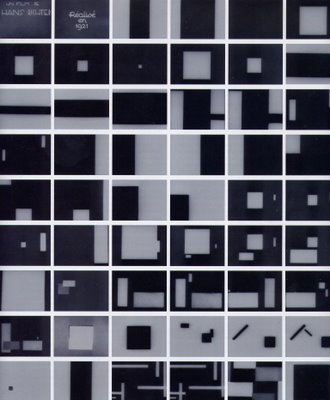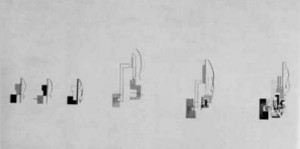|
Hans Richter (1888 � 1976) and Viking Eggeling�s collaboration was predicated on similar interests, and developed, at least initially, from Richter�s desire to work together. In the summer of 1919, he invited Eggeling to visit his family�s estate in Klein-K�lzig, Nieder Laustiz, Brandenburg in Germany. This marks the beginning of their formal collaboration, and art historian Martin Norden has noted the parallels and connections between the abstract language Eggeling and Richter produced, and similar attempt to create a formal language by other artists. After 1920, Richter worked to promote their Universelle Sprache using his relationships with other abstract artists: the De Stijl artists in the Netherlands, the Dada/Constructivists in Berlin and the Russian artist Kasimir Malevich�s Suprematism. Norden�s recognition of the formal relationship between Suprematism, the geometric painting of De Stijl artists Piet Mondrian and Theo van Doesberg, and the Universelle Sprache created by Eggeling and Richter is not simply a coincidence. Their collaboration developed because of Richter�s associations with these groups and mutual friends they shared in them.
Theo van Doesberg introduced Richter to Eggeling in 1918 during a visit to Zurich, Switzerland, and in 1920, van Doesberg was promoting their work with the abstract scroll paintings to the De Stijl group, which included Mondrian; van Doesberg�s 1921 discussion of abstract film was illustrated using images by Richter and Eggeling. The formal language developed and proposed by Richter and Eggeling found publication in De Stijl, and reflects their participation in the larger aesthetic developments of the 1920s.
Richter�s relationship with Kasimir Malevich was equally direct: he organized the Berlin exhibition of Malevich�s paintings in 1927, and was appointed curator of these works, stored in Hannover. During this visit they planned an abstract film to demonstrate the translation of the principles of Suprematism into motion. The planned film was never produced, remaining instead a collection of notes and sketches for how the work would develop.
The transfer of the formal language proposed by their Universelle Sprache into motion pictures was problematic for Richter. The attempt to adapt structures and form-sequences from his scroll-paintings are apparent to varying degrees in Richter�s Rhythmus 21, Rhythmus 23, and in stills of Rhythmus 25 (apparently lost). Rhythmus 21, Richter�s first completed film was originally titled Film ist Rhythmus, �Film is Rhythm,� and may not have been completed until 1924, but parts of the unfinished film were shown starting in 1921. It developed the ideas of their Universelle Sprache in a new direction, largely independent of the designs and aesthetic employed in his scroll painting Praludium (1919); his abandoning this first project may have led to the arguments and the end of his direct collaboration with Eggeling in 1921. The difficulty in producing the animation lay with the complexity of forms: as a result, the UFA animator assigned to animate them took longer than Richter wanted, an issue discussed at length in his memoir about these films Easel-Scroll-Film (1952), and apparently was not very supportive of the project Richter had conceived. His completed film was not based on the designs and technique employed in creating of the scroll paintings:
I wanted to understand better what I was doing and decided, very much against Eggeling�s arguments, to start from scratch again�using the principle of counterpoint to guide me. This time I did not concentrate upon orchestrating form�but time, and time alone.
The simple square of the movie screen could easily be divided and �orchestrated.� These divisions or parts could then be orchestrated in time by accepting the rectangle of the �movie-canvas� as the form element. Thus, it became possible to relate (in contrast-analogy) the various movements of this �movie-canvas� to each other�in a formal as well as a temporal sense.
[Robert Russert and Cecile Starr, Experimental Animation (New York; Da Capo, 1976) p. 53]

Hans Richter, stills from Rhythmus 21
Richter�s organization of Rhythmus 21 follows a harmonic division of the screen, with different parts being animated using squares in white and black. The full duration of the film employs superimpositions and loop printing of his animation in both positive/negative and forward-reverse. This repetition of animated elements gives the finished piece a structure where the transformation from positive to negative, and the reversal of animated actions, as in Eggeling�s work, suggests the harmonics of musical scales, crescendos and decrescendos. As Richter�s description of the idea of �a movement� posed in their Universelle Sprache states��it must be completed, a world of its own��each revelation of a form stands largely apart from the forms that follow it. In the sequences created by this arrangement, the harmonies and elaboration of visual motifs happens through the variations these compositions reveal. In Rhythmus 21 and Rhythmus 23, each �movement� is a complete unit unto itself, leaving the modulations and patterning of moving forms to a different work.
Animated at an even pace, Richter�s organization of �time,� as Moholy-Nagy noted in his discussion of Eggeling�s work with film, is distinctly limited to shifts of graphic relationship on screen, not to modulations of how fast or slow the squares and rectangles move. The structure is one where the frame of the screen is referenced by animated bands that slide horizontally and vertically across it; there are no curves, circles or rounded elements in this film. These are followed by a square diminishing in size. Each of these actions is repeated a few times before the next sequence of animation begins. Running only around 3 minutes, the finished work depends on the fragmentation and restoration of the full frame projected on screen. These movements are a realization of the precise syntax and structure of the language Richter and Eggeling proposed, based on the geometric and didactic presentation of its principles: this is claim that �each movement must be able to exist in itself� shown in actual practice. The elaboration of these basic units of division and motion over the duration of the film follows from the compartmentalized foundation of the formal language. The isolation of each animated block where the reference is the screen�s shape follows from the analogy between the screen and the surface of the painting: Rhythms 21 is an animated painting, its abstraction follows from and develops the potential and implied motions of static art using animation. The sense of fragmentation felt in the experience of watching this film is essential to its meaning and design�a reflection of the iconic aspects of their Universelle Sprache.
The interplay between light and dark produced by the negative loops and the reverse sequences offers an opportunity to consider the shape of the screen as a positive and negative field upon which these rectangles and squares shift between being filled, solid space, and empty space. These graphic relations between figure and field are the subject of his animation, and are what he means by �counterpoint� in discussing the result. 
Hans Richter, Praludium
Rhythmus 23 (1923) is markedly more complex both in its execution of the movement, and in the varieties of forms. It premiered in Paris during the film program of the Soiree du Coeur � Barbe. Again, Richter�s design did not include curves or ellipses, focusing only on the use of rectilinear elements and straight lines. His earlier film experiments with adapting his 1919 scroll painting Praludium were incorporated into the finished film that primarily employed diagonal motifs in its organization. Where Rhythmus 21 was built from the figure/field dynamics of solid planes and shapes in motion, the reintroduction of linear elements made in his initial film experiment allows a dynamic exploration of the relationships between solid and linear forms, and shows a construction of the differences and similarities between them. The different graphic potentials of these forms becomes apparent: as in the Richter�s first completed film, Rhythmus 23 employs positive and negative loop printing to reverse the figure/field relationships of his forms, but with the additional factor posed by the linear elements as a mediating force in their spatial relationship.
In Rhythmus 25 (1925) Richter returned to working with a scroll-painting as the foundation for a completed film: Orchestration der Farbe �Orchestration of Color� (1923). Unlike his earlier abstract films, Rhythmus 25 employed tinting to add color to different forms, following the design of his painting. The coloring Richter used in the film works to group the forms in similar ways to the scroll-painting they are modeled on. His color theory was based on a red-green opposition:
Between green and red are all the colors, as between black and white is all the light. The scientifically denominated elementary colors, blue, red, and yellow, do not have, aesthetically speaking, an absolute distance from each other. Red and yellow are nearer (warm); blue is opposite of yellow as well as of red; whereas green and red are incomparably unequal to each other� All other colors I consider more or less variations.
[Cleve Gray (Ed.), Hans Richter by Hans Richter (New York: Holt, Rinehart and Winston, 1971), p. 85.]
Perhaps because of the difficulty and expense with producing the hand-colored print of Rhythmus 25, Richter only produced one copy, now lost. His use of this particular pair of opposites, in contrast to the yellow-violet of Impressionism, reflects the more dynamic thinking of avant-garde painters starting with the Fauves, in particular, Henri Matisse, whose works extensively employ a red-green opposition to create their dynamism. It premiered in the same film program as Eggeling�s Symphonie Diagonale sponsored by the Novembergruppe in 1925.
Taken together, his surviving films Rhythmus 21 and 23, are a demonstration of the visual potentials of the language Richter and Eggeling developed as Richter understood it. This distinction is significant, since in the production of these films he has acknowledged that he chose to deviate from how they proposed the Universelle Sprache for graphic forms�it was modified for use in his films, thus the actual parameters of this system do not entirely correspond to their application within these films. That the parameters imposed by working in black and white were limiting can be recognized in the use of hand-coloring for Rhythmus 25. The aspiration to demonstrate the possibility of an abstract, universal language based in perception that Richter�s films reveal is particular to the Constructivist aesthetics developed in the 1920s. It is the element of these works which places them beyond the scope of being purely Dada provocations, contrasting as it does with the provocations and nihilism common to that movement.
|

|